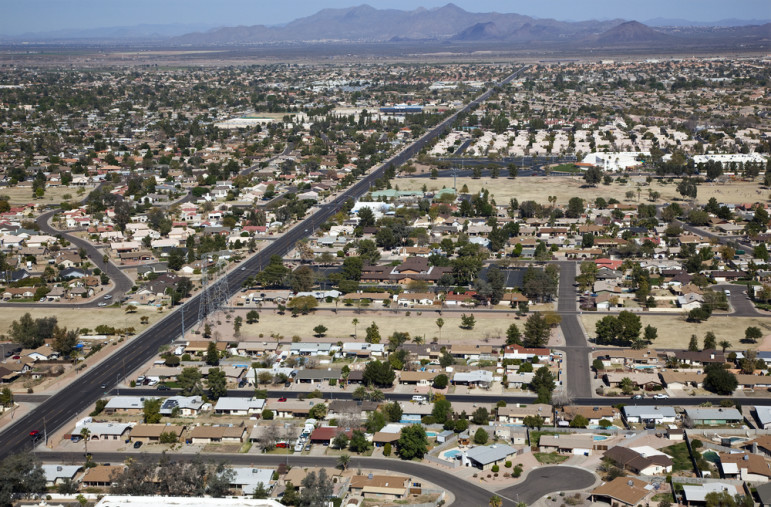
February 8, 2016; Tucson News Now
Subsidized housing for a specific population would not be welcome in every community, and might not be expected to receive unanimous support from the city council of America’s most conservative big city, Mesa, Arizona. But this week, plans for a $14 million affordable housing development for struggling artists took a big step forward when the Mesa City Council voted 7-0 to continue working with Minneapolis-based Artspace on a 77,000-square-foot project for “struggling artists” near downtown. Construction could begin early in 2017, on a project that’s been in the talking stages for about three years.
If the deal goes through, Mesa taxpayers would underwrite some of the costs, including a $230,000 piece of real estate, and 50 percent of the utility costs for the first three years of the finished space. In addition to helping Mesa change its conservative image, the city fully expects to see economic benefits from the project. Augie Gastelum, who works for the Neighborhood Economic Development Corporation in Mesa, explains, “It’s proven all over the country that artists begin to change communities and they begin to impact the community economically. People don’t really think of arts as an economic driver, but it is.”
Of course, what’s also been proven all over the country is this: Once artists move into neglected buildings or challenged neighborhoods and help to revitalize those spaces and communities, the properties become so desirable that the artists can no longer afford to live in them and have to move elsewhere and start all over again. There’s a tipping point with gentrification, and artists often find themselves on the wrong side of the scale after they’ve invested all they’ve got into reshaping a community. This is one of the reasons why the words “struggling” and “artists” can’t seem to stop keeping company with each other.
Camille LeFevre, editor of the Minneapolis-based online publication The Line, explains this pattern, which has been called “the SoHo effect,” in an article titled “Is Affordable Artist Live/Work Space the New Normal?” This is one in a series of three thought-provoking pieces she wrote (with support from Artspace, it should be noted) about the trend for communities across the U.S. to invest in affordable housing developments for artists that are planned—and funded—to remain affordable and to continue to be lived in and worked in by artists. The trend began in the late 1980s, but has really gained traction in recent years. Artspace has been at the forefront of this movement and continues to operate as “a nonprofit real estate developer with the mission of creating and preserving affordable live/work housing for artists, so artists could stay in the neighborhoods they helped renew.” Artspace opened its first project in St. Paul, Minnesota, in 1990; went statewide in 1996; and by 2007 had developed 14 artist live/work housing developments across the U.S. Other developers have adopted similar models. Cities like New York and states like Colorado are embracing these types of projects, recognizing the value of not only attracting but also retaining creative residents.
Sign up for our free newsletters
Subscribe to NPQ's newsletters to have our top stories delivered directly to your inbox.
By signing up, you agree to our privacy policy and terms of use, and to receive messages from NPQ and our partners.
Among the lessons learned along the way have been the challenges of navigating complex funding streams and tax laws relating to affordable housing. As LeFevre reports:
When Artspace began looking for ways to create affordable artist live/work housing, the organization had to learn how to make the projects financially feasible. “It was a lot of trial and error,” recalls Catherine Jordan, former board chair of Artspace, “a real rat’s nest of trying to figure out how to put the dollars together. We looked at existing funding streams and discovered how to apply them to artists. We figured out how to attract the tax increment financing, and city and county funding. We were on the cutting edge of fitting this thing out.”
When an IRS audit pointed out that Artspace’s artist-preference policy violated the tax credit law, because the buildings weren’t available for general public use, Artspace and its supporters successfully lobbied to revise the housing law. In 2008, the new law included a clarification allowing preferences for tenants involved in “artistic or literary activities.” Today, being an artist remains the only occupation specifically singled out in the law.
Anyone interested in learning more about the social impact of artist live/work developments—or anyone who needs a little more convincing about their economic impact—would be well advised to read the other two articles in LeFevre’s series:
- “Funding, Policy, Persuasion, Need: How Artspace Gets Affordable Artist Live/Work Housing Done”
- “Artists Can Be the ‘Connective Tissue’ of a Neighborhood, But First Need Affordable Housing”
—Eileen Cunniffe













